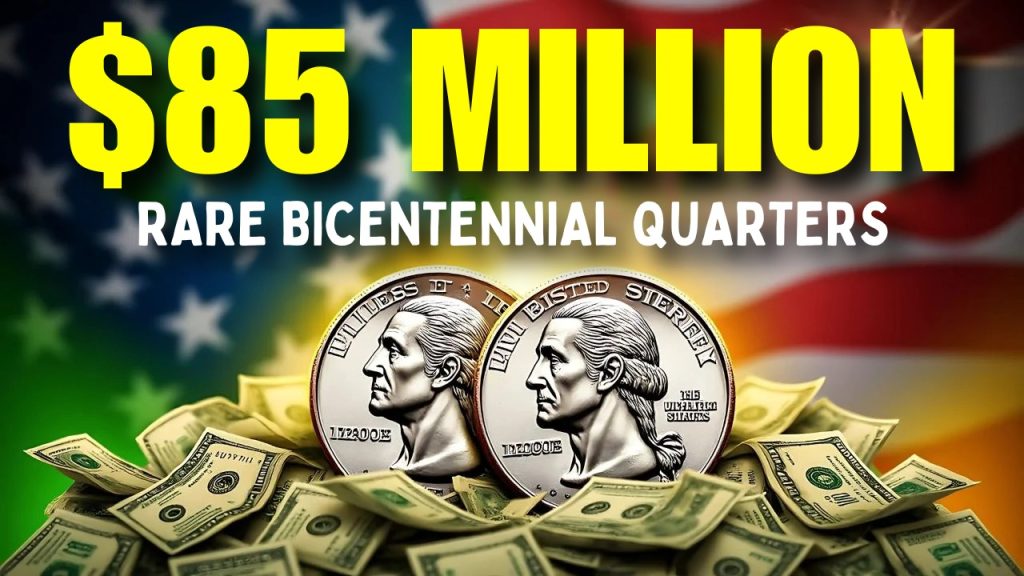
The 1976 Bicentennial Quarter holds a special place in American numismatic history, marking the nation’s 200th anniversary of independence. Unlike typical coins, this limited-edition quarter features a unique design that distinguishes it from other U.S. currency. As one of the most notable coins in the collection world, the Bicentennial Quarter is not just a currency but also a historic treasure that has captivated collectors worldwide. Some of these coins have even fetched up to $85 million, showcasing their exceptional value.
THE History Behind the Bicentennial Quarter
In 1973, the U.S. Mint set out to commemorate the country’s 200th anniversary by producing a special coin that would celebrate America’s independence. The Bicentennial Quarter was the result of a nationwide design competition. The coin’s final design, which featured a unique reverse image, was chosen, and production began in 1975. The coins were minted across three facilities: the Philadelphia Mint (no mint mark), the Denver Mint (D mint mark), and the San Francisco Mint (S mint mark).
Symbolism of the Bicentennial Quarter’s Dual Date
The most striking feature of the Bicentennial Quarter is its “1776-1976” dual date. This symbolizes the 200 years that have passed since the signing of the Declaration of Independence in 1776 and the milestone year of 1976, marking the Bicentennial celebrations of the United States.
Varieties Produced by the U.S. Mint
The U.S. Mint produced two types of Bicentennial Quarters:
- Copper-Nickel Plated Versions: These coins were created for general circulation and are commonly found in pockets across the country.
- 40% Silver Collectible Versions: These coins were produced for collectors and are considered much more valuable than their copper-nickel counterparts.
- Proof Editions: Special proof editions were minted at the San Francisco Mint, known for their fine finish and high-quality appearance.
Why Are Bicentennial Quarters So Valuable?
The Bicentennial Quarter’s value is influenced by several factors. Here’s a breakdown of what makes these coins particularly desirable to collectors:
- Rarity: While millions of Bicentennial Quarters were minted, certain versions, particularly those with minting errors or unique features, are rare and highly valuable.
- Condition: Coins in mint or near-mint condition, especially those graded MS-65 or higher, can fetch impressive prices.
- Minting Errors: Some Bicentennial Quarters feature unique manufacturing errors, such as doubled die or off-center strikes, which increase their value significantly.
- Historical Significance: The Bicentennial Quarter represents a significant moment in American history, marking the nation’s 200th anniversary, making it a cherished collector’s item.
How to Identify Valuable Bicentennial Quarters
To determine whether your Bicentennial Quarter is valuable, consider these important factors:
- Mint Marks: Look for mint marks to identify where the coin was produced: “D” for Denver, “S” for San Francisco, and no mint mark for Philadelphia.
- Condition: Coins in pristine condition, particularly those with no signs of wear or damage, are worth more.
- Rarity and Errors: Minting errors such as doubled dies or off-center strikes can increase the coin’s value substantially.
- Proof Editions: Special proof editions with a high-quality finish are particularly valuable.
Factors That Contribute to High Prices at Coin Auctions
Several factors play a role in the price a Bicentennial Quarter can command at auction:
- Condition: Coins in uncirculated, mint condition are valued far higher than those that show signs of wear.
- Market Demand: The demand for rare coins can drive up auction prices, especially when multiple collectors are bidding on the same piece.
- Provenance: Coins with a notable ownership history or those once owned by famous collectors can fetch higher prices.
- Authentication: Certification from trusted organizations such as the Numismatic Guaranty Corporation (NGC) or Professional Coin Grading Service (PCGS) can add significant value to a coin.
Additional Rare Coins Worth Over $50 Million
In addition to the Bicentennial Quarter, there are other rare coins that have fetched astronomical prices at auction. Some examples include:
- 1796 Draped Bust Quarter: Known as the first quarter-dollar coin ever minted, it holds immense historical value and can be worth over $50 million.
- 1932-D Washington Quarter: With only 436,800 coins minted, this rare coin can command prices over $65 million.
- 1804 Draped Bust Quarter: This coin, produced in limited numbers, can reach up to $75 million for well-preserved examples.
Tips for Beginning Your Coin Collection
If you’re interested in starting your own coin collection, here are some essential tips to help you get started:
- Join Numismatic Organizations: Organizations such as the American Numismatic Association (ANA) and the Numismatic Guaranty Corporation (NGC) offer resources and support for collectors.
- Learn the Basics: Read guides like the Red Book or Cherry Picker’s Guide to better understand coin values and identification.
- Invest in Quality Tools: Get a magnifying glass with 10x-20x magnification and a scale to weigh your coins accurately.
- Start Small: Begin by focusing on a specific series or year and build your collection slowly over time.
- Consult Experts: Connect with experienced dealers or attend coin shows to enhance your knowledge.
Conclusion
The 1976 Bicentennial Quarter is more than just a coin; it is a significant part of American history. With its unique design, historical importance, and the potential for rare varieties, it remains one of the most sought-after coins among collectors. Whether you’re a seasoned collector or just starting, keeping an eye out for these rare quarters could lead you to a valuable piece of U.S. history.
FAQ’s
Q = What makes a Bicentennial Quarter valuable?
Bicentennial Quarters are valuable due to their rarity, condition, and the presence of minting errors. Special editions like the 40% silver proofs are particularly sought after.
Q = How can I tell if my Bicentennial Quarter is rare?
Check for unique features like minting errors or high-quality proof versions. Also, the condition of the coin plays a major role in its value.
Q = What is an MS70 grade for a coin?
An MS70 grade signifies that the coin is in perfect condition with no visible imperfections, making it highly valuable.
Q = What other rare coins are worth more than $50 million?
Coins such as the 1796 Draped Bust Quarter, the 1932-D Washington Quarter, and the 1804 Draped Bust Quarter are also worth over $50 million.


